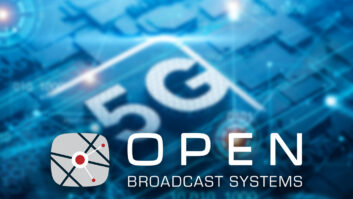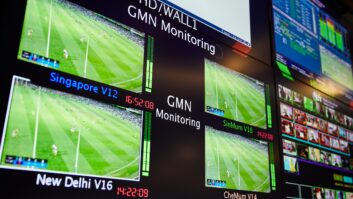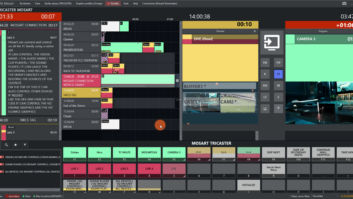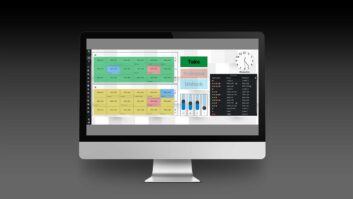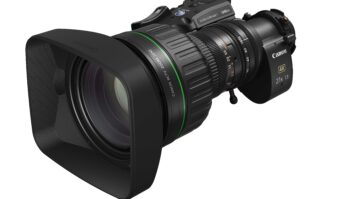By Melanie Dayasena-Lowe
Independently-owned playout and TV facilities company ABS Broadcast has opened a brand new 32 channel playout centre in Park Royal, London to meet its growing customer base. Now boasting two active playout centres, ABS has grown to meet needs in an ever-changing technology environment.
Sass Jahani, managing director of ABS Broadcast, says the company first started over 20 years ago. Originally a BBC broadcast engineer, Jahani left to start the company Advanced Satellite concentrating mainly on systems integration work in Africa. When Sky Digital launched in 1998, he started to receive enquiries from channels about setting up and looking after their facilities in the UK.
A year later ABS Broadcast launched its first playout, starting with 6-7 channels and growing up to 15 channels. This is where British companies such as systems integrator VSC Design and Trilogy Communications became involved in the project in terms of design and technology supply.
As one of the new players in the playout sector, Jahani explains how his company changed the rules: “We were the first server-based playout, and people weren’t too sure about servers.” In 2004 the second playout was built, handling 25-30 channels with more channels being added every five years.
The newest playout centre has been designed and installed by VSC Design and kitted out with Trilogy equipment among other technology systems. The first playout centre has since been decommissioned.
UK-based VSC Design has been working with ABS for 10 years. “We were initially engaged by ABS to build a 12 channel playout system at their premises in Park Royal. The facilities were then expanded in 2003 with the addition of a new 16 channel system in a new building,” explains Martyn Hales (pictured), managing director.
This existing relationship led to VSC’s involvement in the newest playout centre. Hales adds: “We have built their original playout channel facility and then upgraded it to capacity. This led to the requirement for the new playout centre to allow ABS Broadcast to expand its channels’ capacity even further.”
The right kit
When it came to technology choice, Jahani at ABS Broadcast had his own clear idea of what he wanted. “I am looking at PubliTronic, Grass Valley, Trilogy – putting these technologies together to deliver a solution for a customer’s problem is what I do. The physical delivery of how you put it together, make it work, run the cables and do the final design is what VSC is brilliant at.”
Hales describes how the installation has been designed to meet future growth prospects. “ABS will add channel functionality to meet their future clients requirements. We were careful to design a flexible system that would allow any future requirements to be handled with a minimum of modification.” ABS also required a flexible monitoring solution, which would provide alarms to operators should there be any breaks in transmission. VSC developed a design based around Miranda Kaleido X multiviewers to meet this requirement.
Among the technology chosen for the new playout centre was Trilogy’s Mentor XL Master Reference Generators. VSC Design first introduced Trilogy to ABS Broadcast back in 1999 and Jahani was impressed by the company’s support and attitude.
Trilogy’s Mentor XL’s manage the transmission of many major TV channels across the globe and was selected by ABS Broadcast as it was the only sync pulse generator that was able to meet all the desired functionality while keeping to the required budget. It avoids the need for numerous option boards or factory upgrades by allowing optional features to be activated via a standard IP connection.
The Mentor XLs were also specified with GPS receivers, which allow for all video, timecode and audio signals to be locked to a single stable reference. The other key benefit of using GPS as the reference source is that it also allows the Mentor XL to act as an NTP server for all other PC-based broadcast equipment.
Barry Spencer, general manager Broadcast, Trilogy Communications, says “our aim is to put it all in one box because it all needs to be reliable. It all needs to have a detection and changeover system in the event of failure. It all needs to log to one reference source so everything is synchronous.
“It’s not like we’re pushing the boundaries of broadcast with 3D technology; we’re providing a core infrastructure product that has to do the job that’s needed now and in the future — and we’re constantly evolving it.”
MAM at the ready
The new ABS playout centre has an area dedicated to Media Asset Management and digitisation. “Where we are trying to move to is MAM,” says Jahani (pictured left with Trilogy’s Barry Spencer). “It’s a big investment for some of the channels. I think it is something that is here to stay. It is going to be the bedrock of some of the broadcasters to get MAM established.”
The other area of growth is digitisation where broadcasters can turn material on tapes into digital content to maximise revenue. “We’ve made investment and we think the way it’s going to go is people who have hundreds or thousands of hours of content sitting on shelves will realise that by digitising it they could create some revenue.
“When a dashboard view is put together for people to browse and buy it, new income streams will appear for some of the content owners. We’re trying to get some of the digitisation going and get MAM to enable those people to then browse, search and buy etc,” he explains.
Jahani sees MAM and digitisation as complementary. “I see digitisation as step one of getting into MAM. Putting MAM in is a scary thought for a company with 300-400 people because you have to break down some departments to get MAM.”
Absolute power
ABS has packaged this as the Absolute Delivery Platform, explains Ted Gush, head of marketing at ABS Broadcast. “The claim we make is that it will take content from any content owner anywhere in any format and deliver it to any broadcaster anywhere in any format. Then you start looking at how that happens? Most people in the MAM space are only at the end of delivery, not at ingest and digitisation at the front as well.”
The final part is delivery, says Jahani. Once content is on the platform, it’s available to anybody who needs it. ABS has developed its Absolute platform to be cloud-based. “The other part of broadcast that’s a given is cloud – do I really care where it is? I just want to make it available to people. We’re definitely going in that direction.”
The facility takes the pressure off content owners by handling content in different formats: “Don’t worry about it, you give me your DigiBeta that you are familiar with, we will take care of the rest in terms of managing it, digitising and delivey,” says Jahani.
The new playout centre went live with two channels in mid-January and the facility is launching or migrating channels at the rate of one per week. It has a programme of 20 channels going live in 20 weeks.
The Master Control Room in the newest playout centre features MAM as one part of its Absolute Delivery Platform. The facility’s digitisation centre receives tapes, these are digitised using Flexicart or VTRs, put into the digital storage archive and ABS provides 24/7 support for managing it.
“We can then sell MAM as a service rather than just selling kit. We digitise it and we look after the content.” The facility can digitise up to 150,000 hours a year in SD/HD, he says.
The new unit was launched with its large customers such as Farsi1, part of News International, and Sony channels such as SET, SAB and MAX. Eleven Sony channels are currently being migrated to the new unit. “An international feed comes to us, we localise it, chop it up, regurgitate it, put commercials in, time delay it and send it to various territories – from here to Canada, US, Europe, UK, Africa, India,” Jahani explains.
Technology at a glance
• New Miranda Multiviewer
• Crystal Vision distribution
• Miranda ‘Solo’ Audio monitoring
• PubliTronic servers
• Snell routing
• A small studio, designed by VSC Design, based on a Tricaster vision mixer, three cameras, lighting using a floor standing grid due to the limitations of the location
• Trilogy Communications Mentor XL Master Reference Generators
